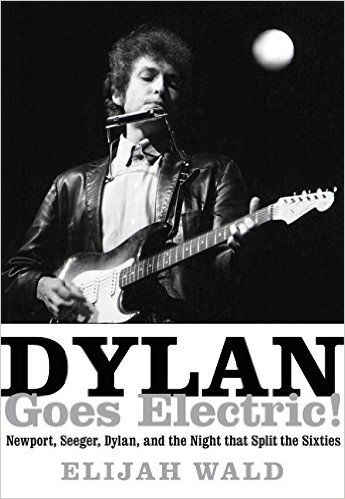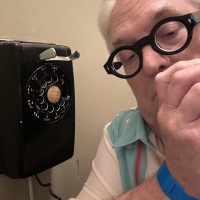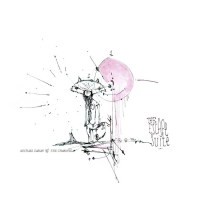Home » Jazz Articles » Book Review » Dylan Goes Electric!: Newport, Seeger, Dylan, and the Ni...
Dylan Goes Electric!: Newport, Seeger, Dylan, and the Night that Split the Sixties by Elijah Wald
 Dylan Goes Electric!: Newport, Seeger, Dylan, and the Night that Split the Sixties
Dylan Goes Electric!: Newport, Seeger, Dylan, and the Night that Split the Sixties Elijah Wald
368 Pages
ISBN: #978-0062366689
Dey Street Books
2014
Critic Elijah Wald might best be termed a critical anthropologist/archeologist of American Music, reexamining what has previously been written, seeking that which has not, and, by widening his net of inquiry, providing a new and broader musical landscape from which to draw previously unconsidered conclusions. Wald is the author of some 12 books, two of which: Escaping the Delta: Robert Johnson and the Invention of the Blues, (Amistad, 2005) and How the Beatles Destroyed Rock 'n' Roll: An Alternative History of American Popular Music (Oxford University Press, 2009) can be taken with his present offering, Dylan Goes Electric!: Newport, Seeger, Dylan, and the Night that Split the Sixties as a trilogy devoted to a soul-cleansing reassessment of American Music from early blues and jazz through rock 'n' roll.
The story surrounding Bob Dylan's performance on Sunday, July 25, 1965 at the Newport Folk Festival has been as tarnished from myth and misrepresentation as Robert Johnson's guitar prowess was from his sale of his soul to the devil. The greater part of music reportage on the subject to date as spent more time focusing on the negative reactions, including Pete Seeger's, to the performance than the positive reactions. And, little or no attention has been paid the much larger American Musical picture in the mid-1960s. Like any idealistically-conceived social movement, the folk music revival (which I will include the blues revival of the same period in) of the late 1950s and early 1960s was based on the white, middle-class, left-leaning discovery of music thought to be pure and unsullied by commercial interests. The blues of the south and the folk music of Appalachia was seen as music of the populace (or proletariat, was this viewed through a critical theory lens) and it was, by and large, promoted this way by the likes of Pete Seeger, the Weavers, and Dave van Ronk.
What these pioneers in the 1950s did was begin a musical folk movement that would reign on the record charts in the early 1960s with the Kingston Trio, the Brothers Four, Peter, Paul and Mary, The Limeliters, The Chad Mitchell Trio, and Ian and Sylvia. By the mid-1960s, Bob Dylan, Joan Baez, Judy Collins, and Tom Paxton came into the picture. But by this time, the landscape was changing. The British Invasion began in full swing, affecting every part of the American musical landscape. What resulted was a turf war between the traditionalists (Seeger, et. al.) and the progressives (Dylan and the Butterfield blues band). Boiling point was reached at the 1965 Newport Folk Festival where all of the factions present were trying to "out-authentic" one another: Pete Seeger claiming the original vision corrupted, while Alan Lomax noted that Son House and Muddy Waters had more genuine bona fides than Paul Butterfield, who, in turn, claimed more genuine bona fides that the Rolling Stones, etc. and, finally, Albert Grossman, with the lion's share of artists under his management coming to blows with Lomax over the whole thing.
The hard-core folk movement had placed most of their eggs in the basket of Bob Dylan, considering him the heir-apparent to the Godfather of the movement, Woodie Guthrie, who was to die of Huntington's Chorea the same year as the folk movement, during the "Summer of Love," 1967. When Dylan came out and blasted "Maggie's Farm" backed by members of the Butterfield Blues Band, they felt betrayed and reflected that feeling at the concert and those occurring subsequently. Dylan had caused the great old-new schism. Or did he?
Wald, has he has done in past books, presents, in detail, the environment in which Sunday, July 25, 1965 served as some kind of creative and cultural pinnacle. First, he describes the early seeds of the folk movement and the role which its greatest purveyor, Pete Seeger played. He does this against a timeline of the Early 1950s to 1965. Secondly, Wald details the rise of Bob Dylan, whose timeline overlaps that of Seeger and in that overlapping the two become forever intertwined. Finally, Wald describes the history of the Newport Folk Festival and the roles both Seeger and Dylan played in it.
In his careful analyses, Wald notes that Dylan never agreed to take the mantle of Guthrie, it was thrust upon him. Dylan always had bigger fish to fry and he used Newport as his launching pad. Wald showed the traditional folk revivalists as well-meaning but naïve proponents of music in general. "Aftermath," the final section of the book is a Tour-de-force where Wald hammers the universal point that even liberal thinking and outlooks can solidify into something conservative. In framing the immediate reaction, Wald uses Peter Yarrow as the simple folk Everyman, wanting everyone to get along. In the bargain, Yarrow comes off as a bathetic beat caricature of soft-spoken lefties singing, "If I had a Hammer:"
"Peter Yarrow is convinced that Dylan could have played the same songs with the same instrumentation and been accepted, saying he advised him to ease into the electric set: "Sing a couple of songs acoustically, then say, 'I've been working in this new way and it's very exciting and I want to share it with you.' Because then they'll understand that this is not necessarily something that contradicts who you are and what you're about."
"The problem with that advice was that Dylan was showing exactly who he was and what he was about, and had no interest in proving he was still part of a precious folk clique."
Wald closes in on his Gotterdamerung, quoting producer Jim Rooney in a letter to the Newport Folk Festival board:
"'The People' so loved by Pete Seeger are the mob so hated by Dylan. In the face of violence he has chosen to preserve himself alone...And he defies everyone else to have the courage to be as alone, as unconnected, as unfeeling toward others, as he. He screams through organ and drums and electric guitar, 'How does it feel to be on your own?' And there is no mistaking the hostility, the defiance, the contempt for all those thousands sitting before him who aren't on their own. Who can't make it. And they seemed to understand that night as for the first time what Dylan had been trying to say for over a year—that he is not theirs or anyone elses.
Wald then goes on to point out a political scenario that played out as recently as the 2012 Presidential election, using Rooney's voice:
"It was not pretty, but 'it was head and shoulders above the easy mouthing of conventional liberalisms.' Everyone had gotten used to being affirmed and comforted by like-minded people. "And the only one in the entire festival who questioned our position was Bob Dylan."
Like the right-wing media pundits in 2012, talking to one another in their echo chamber and never looking outside until against all their conflated odds, they had lost. The traditional folkies never turned around to see what was coming up behind them. Dylan ran out in front of them just in time to scare the shit out of them before they, the folk old guard, were overrun by the inevitable British Invasion and everything else that transpired in the second half of the 1960s. And that is what Bob Dylan has always been about.
Tags
PREVIOUS / NEXT
Support All About Jazz
 All About Jazz has been a pillar of jazz since 1995, championing it as an art form and, more importantly, supporting the musicians who make it. Our enduring commitment has made "AAJ" one of the most culturally important websites of its kind, read by hundreds of thousands of fans, musicians and industry figures every month.
All About Jazz has been a pillar of jazz since 1995, championing it as an art form and, more importantly, supporting the musicians who make it. Our enduring commitment has made "AAJ" one of the most culturally important websites of its kind, read by hundreds of thousands of fans, musicians and industry figures every month.





















